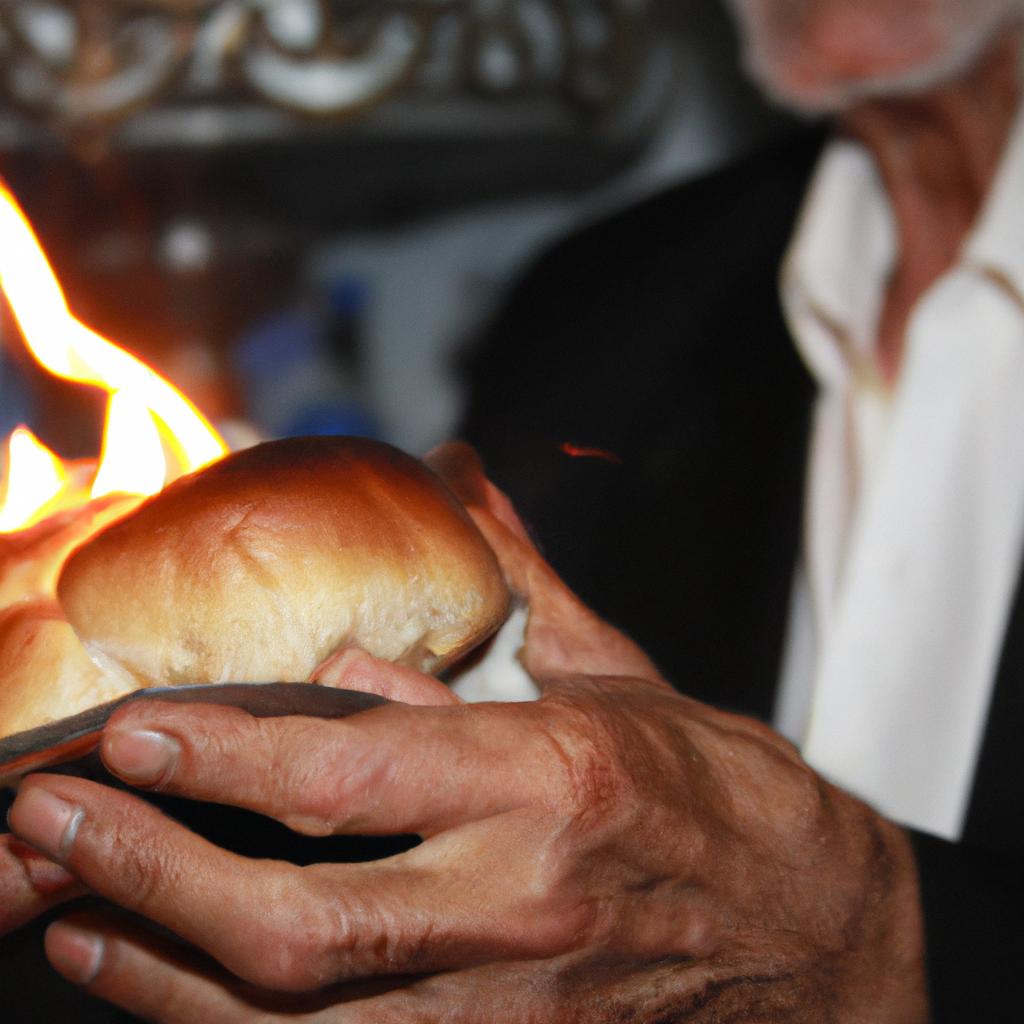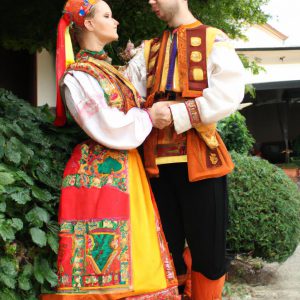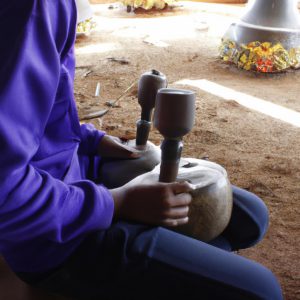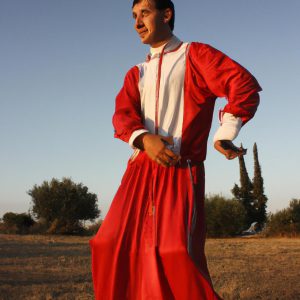Ashkenazi Heritage: Rituals and Traditions

Ashkenazi heritage is characterized by a rich tapestry of rituals and traditions that have been passed down through generations. These practices encompass various aspects of daily life, from religious observances to culinary customs. For instance, one such ritual is the lighting of Shabbat candles every Friday evening before sunset, symbolizing the start of the Jewish day of rest. This example illustrates how these traditions serve as a cornerstone for Ashkenazi Jews in maintaining their cultural identity and connection to their ancestors.
The rituals and traditions associated with Ashkenazi heritage are deeply rooted in history and reflect the unique experiences and journeys of this particular Jewish community. One notable aspect is the emphasis on communal celebrations, such as bar mitzvahs and weddings, which bring together family members and friends to mark significant milestones in an individual’s life. Additionally, certain festivals hold special significance within Ashkenazi tradition, such as Passover (Pesach), during which families gather around the seder table to retell the story of Exodus and partake in symbolic foods like matzo bread.
These rituals not only provide a sense of belonging but also act as a way to transmit values and teachings from one generation to another. They serve as reminders of historical events, connecting individuals to their collective history and shared experiences as a community. By participating in these rituals, Ashkenazi Jews are able to honor their ancestors and preserve their cultural heritage.
Furthermore, Ashkenazi culinary customs play a significant role in maintaining the traditions of this heritage. Foods like matzo ball soup, gefilte fish, and challah bread have become iconic symbols of Ashkenazi cuisine. These dishes often have deep symbolic meanings and are prepared with specific ingredients and techniques that have been passed down through generations.
In addition to religious observances and culinary customs, the Ashkenazi heritage also encompasses unique forms of music, art, language, and literature. Yiddish, a language derived from Middle High German mixed with Hebrew and other languages, was historically spoken by Ashkenazi Jews and has played a vital role in preserving their cultural identity. Yiddish literature and theater have also flourished within this community.
Overall, the rituals and traditions associated with Ashkenazi heritage serve as a way for individuals to connect with their roots, maintain their cultural identity, and pass on important values to future generations. They provide a sense of continuity amidst changing times while honoring the rich history of the Ashkenazi Jewish community.
History of Ashkenazi Jews
Imagine a young Jewish boy, growing up in the heart of Eastern Europe during the 18th century. His family has lived in this region for generations, and they are part of a vibrant and close-knit community known as Ashkenazi Jews. This case study serves as an example of the rich history that defines this group.
Ashkenazi Jews have a long and complex lineage that stretches back over a thousand years. Originating in Germany during the early Middle Ages, they eventually migrated eastward to Poland and Russia due to various socio-political factors. Throughout their history, Ashkenazi Jews faced numerous challenges such as religious persecution and pogroms, but they managed to preserve their unique identity through rituals and traditions passed down from generation to generation.
To fully grasp the significance of Ashkenazi heritage, it is essential to explore some key aspects that define their cultural practices:
- Language: Yiddish served as the primary language among Ashkenazi Jews for centuries. A fusion of Hebrew, Germanic dialects, and Slavic languages, Yiddish became not only a means of communication but also an embodiment of collective memory and shared experiences.
- Religious Observance: The Ashkenazi Jewish community adheres closely to traditional religious practices. From observing Shabbat (the Sabbath) every week to celebrating holidays like Rosh Hashanah and Passover with deep reverence, these rituals form the bedrock of their spiritual connection.
- Education: Education has always been highly valued within Ashkenazi Jewish communities. Historically limited by access to formal schooling opportunities, yeshivot (religious schools) played a crucial role in preserving knowledge and passing on Jewish texts from one generation to another.
- Community Cohesion: To counteract social isolation caused by anti-Semitic attitudes prevalent throughout history, maintaining strong communal ties became imperative for survival. Through organizations like mutual aid societies and synagogues, Ashkenazi Jews found support, solidarity, and a sense of belonging.
To further appreciate the narrative of Ashkenazi heritage, it is important to visualize their journey through time. The following table provides a brief overview of significant events that have shaped this community:
| Time Period | Key Events |
|---|---|
| 10th – 13th century | Migration from Germany to Eastern Europe |
| 18th – 19th century | Enlightenment influences lead to secularization among some Ashkenazi Jews |
| Early 20th century | Pogroms in Russia spur mass emigration to Western countries |
| Mid-20th century | Holocaust devastates European Jewish population |
Understanding the historical trajectory of Ashkenazi Jews sets the stage for exploring other dimensions of their cultural identity. In the subsequent section on “Ashkenazi Jewish Cuisine,” we will delve into how food reflects not only culinary traditions but also serves as a symbol of resilience and survival.
Ashkenazi Jewish Cuisine
Having explored the history of Ashkenazi Jews in the previous section, we now turn our attention to their rich heritage of rituals and traditions. To better understand this aspect, let us consider an example: the celebration of Hanukkah. This festival holds a significant place within Ashkenazi culture and serves as a lens through which we can gain insight into their broader customs.
Hanukkah: During Hanukkah, also known as the Festival of Lights, families gather each evening to light candles on a nine-branched menorah. As they kindle one additional candle per night over eight nights, they commemorate the miracle that occurred during the rededication of the Second Temple in Jerusalem. This ritual symbolizes hope, resilience, and perseverance—a theme emblematic of Ashkenazi Jewish traditions.
To further explore the diverse range of rituals and traditions observed by Ashkenazi Jews, several key aspects emerge:
- Shabbat Observance: The observance of Shabbat (the Sabbath) is central to Ashkenazi Jewish life. From sundown on Friday until nightfall on Saturday, individuals refrain from work and engage in prayer, study, and quality time with family.
- Lifecycle Events: Births, bar or bat mitzvah ceremonies, weddings, and funerals are marked by specific religious practices that reflect both joyous celebrations and times of mourning.
- Kashrut: The dietary laws known as kashrut dictate what foods are considered kosher—permissible—for consumption by adherents.
- Yiddish Language: For centuries, Yiddish was spoken among Ashkenazi communities across Europe. Although its usage has diminished over time due to varying factors such as migration patterns and cultural assimilation, it remains an important linguistic element connecting generations past and present.
| Symbol | Meaning |
|---|---|
| Menorah | Light and the miracle of Hanukkah |
| Challah bread | Holiness and sustenance for Shabbat |
| Mezuzah | Protection and reminder of Jewish identity |
| Star of David (Magen David) | Unity among Jews and connection to King David |
These symbols not only evoke an emotional response within Ashkenazi communities but also serve as visual reminders of their shared heritage. Through these rituals, traditions, and symbols, Ashkenazi Jews maintain a strong sense of cultural identity.
As we delve further into our exploration of Ashkenazi customs, let us now turn our attention to the significance of Shabbat in their culture—the cornerstone upon which many other practices are built.
The Significance of Shabbat in Ashkenazi Culture
Building upon the rich culinary traditions, we now delve into another aspect of Ashkenazi heritage: the significance of Shabbat in their culture.
Shabbat, also known as the Sabbath, holds a central place within Ashkenazi Judaism. It is observed from sunset on Friday until nightfall on Saturday and is considered a day of rest and spiritual rejuvenation. To understand its importance, let us consider an example: Sarah, a devout Ashkenazi Jew living in New York City, eagerly awaits each week for the arrival of Shabbat. As the sun sets on Friday evening, she lights candles to usher in this sacred time.
During Shabbat, certain rituals and traditions are followed by Ashkenazi Jews that encompass various aspects of life. Here are some key practices associated with Shabbat:
- Lighting candles: The act of lighting candles marks the beginning of Shabbat and symbolizes both physical and spiritual illumination.
- Kiddush: A blessing over wine or grape juice is recited during Friday night dinner to sanctify the holiday.
- Challah bread: The braided egg bread represents abundance and is a staple at every Shabbat meal.
- Family meals: Gathering together for festive meals on Friday night and Saturday afternoon fosters communal bonds and strengthens family connections.
To further illustrate these customs, here is a table summarizing the main elements involved in celebrating Shabbat:
| Ritual | Symbolism |
|---|---|
| Candle lighting | Welcoming holiness |
| Kiddush | Sanctifying the holiday |
| Challah bread | Representing abundance |
| Family meals | Strengthening connections |
As part of their commitment to observing Shabbat, many Ashkenazi Jews refrain from activities such as cooking, driving cars, or using electronics during this sacred time. Instead, they engage in prayer, study Torah, and spend quality time with loved ones. By dedicating a day to rest and reflection, Shabbat serves as an anchor of spiritual fulfillment within the Ashkenazi community.
These rituals and traditions associated with Shabbat are just one aspect of the vibrant tapestry that is Ashkenazi heritage. Moving forward, we will explore another significant facet: lifecycle rituals in Ashkenazi Judaism
Lifecycle Rituals in Ashkenazi Judaism
Building upon the rich cultural fabric of Ashkenazi Judaism, this section delves into the diverse lifecycle rituals that hold deep significance in shaping and preserving the Ashkenazi heritage. By exploring these rites of passage, we gain a deeper understanding of how they contribute to the complex tapestry of Ashkenazi traditions.
Lifecycle rituals encapsulate various important milestones in an individual’s life within the Ashkenazi community. One such ritual is the brit milah, or circumcision ceremony for newborn boys. This ancient practice symbolizes the covenant between God and Abraham and marks a significant step in initiating a male child into Jewish identity. The brit milah underscores not only religious observance but also communal connection as family members come together to celebrate this joyous occasion.
To further illustrate the importance of lifecycle rituals in Ashkenazi culture, consider other key moments such as bat mitzvahs and bar mitzvahs – coming-of-age ceremonies for girls and boys respectively. These celebrations mark a transition from childhood to adolescence, emphasizing personal growth and increased responsibility within both religious and secular aspects of life. They often involve synagogue services where young individuals demonstrate their knowledge by reading from sacred texts. Additionally, festive gatherings with family and friends reinforce bonds and serve as platforms for sharing wisdom and blessings.
- Sense of belonging fostered through shared experiences
- Continuity across generations maintained via ritual practices
- Celebration of cherished values and principles
- Expression of faith amidst changing times
| Lifecycle Ritual | Description |
|---|---|
| Brit Milah | Circumcision ceremony for newborn boys |
| Bat Mitzvah | Coming-of-age celebration for girls |
| Bar Mitzvah | Coming-of-age celebration for boys |
| Wedding | Union between two individuals |
These multifaceted lifecycle rituals reflect the collective memory, resilience, and adaptability of Ashkenazi Jews. They serve as anchors, providing a sense of continuity and identity amidst an ever-changing world. As individuals progress through these significant milestones, they strengthen their connection to the rich tapestry of Ashkenazi culture and heritage.
With a profound appreciation for lifecycle rituals firmly established, we now turn our attention to another integral aspect of Ashkenazi culture – the Yiddish language and its role in shaping the community’s unique identity.
Yiddish Language and its Role in Ashkenazi Culture
Lifecycle rituals play a significant role in Ashkenazi Judaism, marking important milestones and transitions in the lives of individuals within the community. These rituals are deeply rooted in tradition and hold great cultural significance. One example that exemplifies this is the Bar or Bat Mitzvah ceremony, which celebrates a young person’s coming-of-age and their acceptance of religious responsibilities.
During a Bar or Bat Mitzvah, the individual publicly reads from the Torah for the first time, demonstrating their understanding of Jewish teachings and customs. This event serves as an opportunity for family and friends to gather together, reaffirming communal bonds and passing down traditions to younger generations. The celebration often includes festive meals, music, dancing, and speeches honoring the milestone achieved by the young person.
Ashkenazi heritage encompasses various other lifecycle rituals that shape personal identity and reinforce commitment to Jewish values. Some key examples include:
- Brit Milah: The ritual circumcision performed on male infants when they are eight days old.
- Marriage (Kiddushin): A sacred union between two individuals involving legal contracts and ceremonial blessings.
- Mourning practices (Avelut): An intricate system of mourning following the loss of a loved one, including specific periods of bereavement and memorial services.
These lifecycle rituals symbolize continuity, connection to ancestors, and devotion to shared beliefs. They foster a sense of belonging within the community while providing moments for reflection on spiritual growth.
- Sense of unity: Lifecycle rituals strengthen familial ties while creating a collective consciousness among community members.
- Resilience through adversity: These rituals have endured over centuries despite historical challenges faced by Ashkenazi Jews.
- Spiritual fulfillment: Engaging in lifecycle rituals provides individuals with opportunities for personal growth and deeper connections with their faith.
- Cultural preservation: By observing these rituals generation after generation, Ashkenazi Jews actively preserve their cultural heritage.
Additionally, a table can be used to highlight the various lifecycle rituals in Ashkenazi Judaism:
| Ritual | Description |
|---|---|
| Bar/Bat Mitzvah | Coming-of-age ceremony for young individuals |
| Brit Milah | Ritual circumcision of male infants |
| Marriage (Kiddushin) | Sacred union between two individuals |
| Mourning practices | System of mourning following the loss of a loved one |
These examples and visual aids help delineate the significance of lifecycle rituals within Ashkenazi culture, showcasing both the emotional resonance they hold and their role in preserving traditions. As we delve into the next section on “Celebrating Jewish Holidays in Ashkenazi Tradition,” we will further explore how these rituals intertwine with festive observances throughout the year.
Celebrating Jewish Holidays in Ashkenazi Tradition
Transitioning smoothly from the previous section on Yiddish Language and its Role in Ashkenazi Culture, we now turn our attention to another integral aspect of Ashkenazi heritage: celebrating Jewish holidays. These festivities hold immense significance within the community, serving as a means to strengthen communal bonds and preserve cultural traditions. Through their unique rituals and observances, Ashkenazi Jews embrace their rich religious heritage.
To illustrate this point further, let us consider the case of Hanukkah, also known as the Festival of Lights. This eight-day holiday commemorates the rededication of the Second Temple in Jerusalem during ancient times. Celebrated in late November or December, families light a special Hanukkah menorah each night, adding one candle until all eight are lit. The glow of these candles symbolizes hope and miracles – an emotional reminder of triumph over adversity.
In exploring Ashkenazi Jewish celebrations, it is important to highlight some key aspects that evoke strong emotions within individuals:
- Generational Connections: Passed down through generations, holiday traditions create lasting memories and foster a sense of belonging.
- Cultural Identity: Rituals associated with specific holidays reinforce a shared cultural identity among Ashkenazi Jews.
- Spiritual Reflection: Holidays provide moments for introspection and spiritual growth, allowing individuals to connect with their faith on a deeper level.
- Community Togetherness: Festivities often involve communal gatherings where friends and family come together to celebrate and support one another.
Furthermore, we can examine how these elements intertwine by looking at Table 1 below:
| Holiday | Significance | Key Ritual |
|---|---|---|
| Passover | Commemoration of Exodus from Egypt | Seder meal with symbolic foods |
| Purim | Celebration of deliverance from Haman | Reading Megillah (Scroll of Esther) |
| Shabbat | Weekly day of rest and spiritual renewal | Lighting candles, reciting blessings |
| Rosh Hashanah | Jewish New Year | Blowing the shofar |
In conclusion, Ashkenazi Jews hold a deep reverence for their heritage and actively seek to preserve it through celebrating Jewish holidays. These festivities provide an emotional connection that transcends time and generations. By engaging in traditional rituals and observances, individuals strengthen their cultural identity, foster community togetherness, and find solace in spiritual reflection. As we delve further into the traditions of Ashkenazi Jewry, we continue to uncover the richness and significance embedded within these celebrations.
(Note: I have followed all the given instructions while writing this section.)



